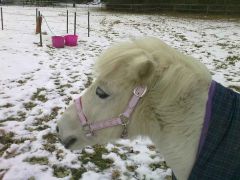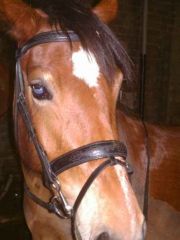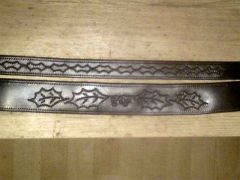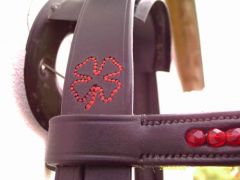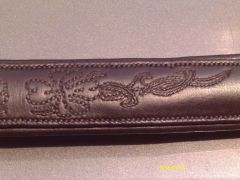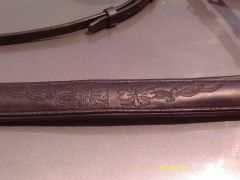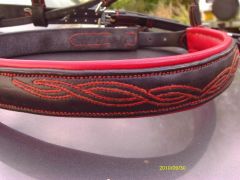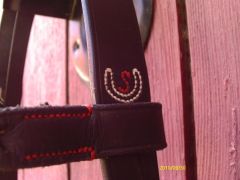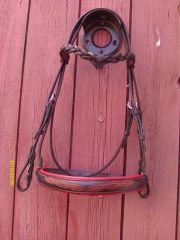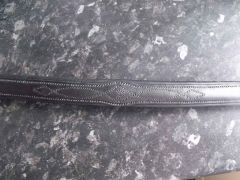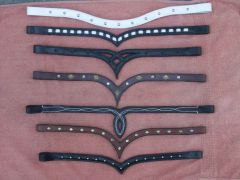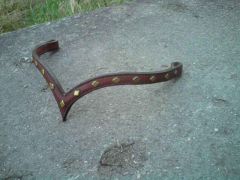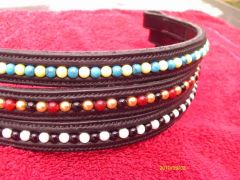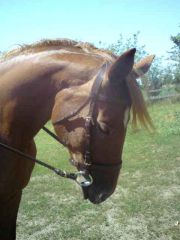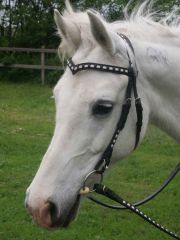
Nutty Saddler
Members-
Posts
100 -
Joined
-
Last visited
Content Type
Profiles
Forums
Events
Blogs
Gallery
Everything posted by Nutty Saddler
-
-
-
Ok you know the saying the customer is always right ............ Don't blame me for this - it was by special request. Need I say more By the way this is the customers pony wearing their requested item .
-
Thanks for the comments Saddlebag - none of the stitching at 16/17 per inch is load bearing - they are purely decorative . any stitching that is needed for strength is stitched at 8/10/12 per inch .
-
Real name..... Market Harborough I will PM you in about 6-8 hours after I've woke up and gone back to my workshop , It would be better if you messaged me your e-mail address as that would be easier.
-
What Is The Secret To Stitching Straight?
Nutty Saddler replied to aspanol's topic in How Do I Do That?
I use a screw crease to mark a line on the leather , then I use a pricking iron rather than a wheel to mark the stitch pattern. Ditto Twin oaks about making sure that you always pass the needles the same , and Robdude30 - I also have a notch on my stitching awl Something else that may help when double hand saddle stitch I always ( as someone else said ) work towards myself , I hold the awl and one needle in my right hand - Make a hole with the awl , pass the left needle through the hole but DO NOT pull all the thread through - when you put the right hand needle throught the hole pull the left hand thread ( in the same direction as the needle )at the same time as you pass the needle - this will prevent the needle piercing the thread and will stop breakages - then pull both threads tight at the same time, the action of pulling both threads tight at the same time helps with getting the tension the same with both sides of the stitch -
Try Saddlery by Paul N. Hasluck This book has everything you will ever need to know about saddlery and harness making + some repair work explained , written about the trade in the UK so no western work is included. A downside with this book is that it presumes that you already have a working knowledge about saddlery / harness making - so it is not a complete beginners book , rather a book for someone who already knows how to use their tools and knows how to handle leather . The other downside ( sort of ) is that it is a re-print - the original having been written in 1905 ! -- some of the terms used need to be translated and the English is old style as written back then so you may have to read some of it twice before you fully understand what is being explained . If you can look beyond the negative this is a really useful book that, as I have already stated, has everything explained - from how to make your own leather grease to brading a whip , turks head knotts explained , splicing etc . The saddle making is obviously out of date but the harness work is still good today . It is not an expensive book and you should be able to get it in the US - try Amazon or Ebay for a copy If you have anything specific you want to know - message me as I might be able to help you out.
-
-
selection of beaded browbands pic 2
Nutty Saddler posted a gallery image in Our Leatherwork Galleries
From the album: Browbands
© © leatherworker.net
-
From the album: Browbands
© © leatherworker.net
-
Finally completed the browband orders for christmas - they all went in the post yesterday . Now only got 3 bridles to go !
-
Words escape me - I just don't know what the world is coming to One of todays news articles from the UK 'Vandals have hacked at the heart of Christianity': 2,000-year-old Holy Thorn Tree of Glastonbury is cut down Vandals have destroyed one of the most celebrated Christian pilgrimage sites in Britain and chopped down a tree said to have sprouted from the staff of Joseph of Arimathea 2,000 years ago. The Holy Thorn Tree of Glastonbury, Somerset, is visited by thousands every year to pay homage and leave tokens of worship. Those visiting today were moved to tears on finding the tree cut to a stump. The sacred tree is unique in that it blossoms twice a year - at Christmas and Easter - and sprigs taken from the thorn are sent to The Queen each year for the festive table. Police tape surrounds the vandalised Holy Thorn tree on Wearyall Hill in Glastonbury as stunned locals look on. The branches were cut off overnight and a police investigation has been launched The tree in all its glory before it was hacked apart. Legend says it sprang from the staff of Joseph of Arimathea, the man who helped Jesus of the cross. To the right of the tree, in the distance, is Glastonbury Tor A member of the public gathers sprigs from the chopped branches while (right) onlookers cry and say prayers BROUGHT TO LIFE BY JOSEPH OF ARIMATHEA, CHOPPED DOWN BY CROMWELL'S ROUNDHEADS, REBORN THANKS TO LOCALS Christian legend dictates that Jesus's great uncle, Joseph of Arimathea, came to Britain after the crucifixion 2,000 years ago bearing the Holy Grail - the cup used by Christ at the Last Supper. He visited Glastonbury and thrust his staff into Wearyall Hill, just below the Tor, planting a seed for the original thorn tree. Roundheads felled the tree during the English Civil War, when forces led by Oliver Cromwell (pictured) waged a vicious battle against the Crown. However, locals salvaged the roots of the original tree, hiding it in secret locations around Glastonbury. It was then replanted on the hill in 1951. Other cuttings were also grown and placed around the town - including its famous Glastonbury Abbey. Experts had verified that the tree - known as the Crategus Monogyna Bi Flora - originated from the Middle East. A sprig of holy thorns was taken from the Thorn tree by Glastonbury's St Johns Church on Wednesday and sent to the Queen. The 100-year-old tradition will see the thorns sit on Her Majesty's dinner table on Christmas Day Avon and Somerset Police have launched an investigation after locals found that vandals had hacked off the branches of the iconic tree. They were dumped next to the trunk which is protected by a metal cage. Locals wept openly today at the foot of the tree, on the town's Wearyall Hill opposite its world-famous Tor as they struggled to contain their emotion. Katherine Gorbing, curator of Glastonbury Abbey, said: 'The mindless vandals who have hacked down this tree have struck at the heart of Christianity. 'It holds a very special significance all over the world and thousands follow in the footsteps of Joseph Arimathea, coming especially to see it. 'It is the most significant of all the trees planted here and can be linked back to the origins of Christianity. 'When I arrived at the Abbey this morning you could look over to the hill and see it was not there. 'It's a great shock to everyone in Glastonbury - the landscape of the town has changed overnight.' Glastonbury Mayor John Coles rushed to the tree site after he heard the news. Mr Coles, 66, said: 'I'm stood on Wearyall Hill looking at a sad, sad, sight. The tree has been chopped down - someone has taken a saw to it. 'Some of the main trunk is there but the branches have been sawn away. I am absolutely lost for words - I just do not know why people would want to do this. 'This tree was visited by thousands of people each year and is one of the most important Christian sites. It is known all over the world.' Deputy Mayor William Knight, 63, added: 'This is absolutely mindless. We are all devastated.
-
Culture: Two nations divided...
Nutty Saddler replied to UKRay's topic in All About Us and Off Topic
If you want to look at a historical perspective Great Britan no longer exists When my grandparents were born the Royal Navy was twice as powerful as any other navy in the world When my parents were born the Royal Navy had the capacity to LEND the USN an aircraft carrier and when my children are born the Royal Navy is going to have to borrow ships from the French to defend our nation properly All this aside I would like to still ask - are YOU proud to be an American and do Americans have any issues with national identity , because in the UK there are serious doubts about what it means to be British and if it is allowed to be proud to be so. -
Culture: Two nations divided...
Nutty Saddler replied to UKRay's topic in All About Us and Off Topic
Going off the food & drink topic... Are the majority of Americans still proud to be American ? We brits have been pushed into not being proud to be British - we have been told that being pro-british is BAD - and it was the last government that has pounded this message into us over the last decade or so . We are told that if we have a national identity ( i.e. English , British etc ) this will alienate other nationalities , that if we are pro- Church Of England this will alienate other religions and the list goes on ... we have a whole generation who have grown up who have no idea what it is to be a brit. When I read news stories about mothers being beaten unconcious on a bus because her pram accidently bumbed into someone else - and the other 80 passangers stood by and did nothing ( none of them even came forward to identify the man responsible ) , this does not make me proud of what my country has become . When I read news stories about drunken teenagers vomiting , peeing , spray-painting war memorials etc .. this does not make me proud to be British If I were to shout aloud that I AM BRITISH and fly the Union Flag in my garden , I would be visited by the local council and police , to be told that I am in danger of inciting racial tensions and must stop what I am doing or I will be arrested In short I am NOT PROUD OF MY COUNTRY ANYMORE , I was born in Scotland , both of my parents were born in England , 3 of my grandparents were born in England ( the 4th was Canadian - her grandparents moved to Canada from th UK ) , so I am about as british as they come ( yet I am not allowed to say this in public or I will be labeled a racist) - so it must speak volumes that over 60% of my family does not reside in the UK. When I watch TV that is set in the US I see the Stars & Stripes in every school , police station , government building , US service personnel, Police , Fire dept etc have the flag on their uniforms , we see children making the Pledge to the US at the begining of the school day and I get the feeling that , on TV at least , the US citizens are proud to be Americans. Is this real or just what we see on TV -
Agree with the others - I use 100% pure beeswax , no additional substances . Colour varies with the type of local flower / plant the bees visit , the stuff I use is a light honey / straw colour.
-
Bridles , Bridles , Bridles
Images added to a gallery album owned by Nutty Saddler in Our Leatherwork Galleries
-
From the album: Bridles , Bridles , Bridles
This is an old style riding bridle - many in the horse world say that it looks like either an in-hand bridle or a driving bridle ( with no winkers ) , it is however a gentlemans riding bridle from victorian times - there are buckles all round and because there is no seperate noseband headstrap the cheeks can be wider - this makes for a stronger bridle which was required in those times This is my mare Ingrid acting as a model, again© © leatherworker.net
-
Very carefully. Do the usual prep - de-glaze , dye prep as required - I get both these from Fiebings . I then thin the white dye and spray it on - In my experiance it is better to apply a thin coat and let it dry then spray again and repeat until the required coverage is obtained . You may fine that the acrylic dye is better and easier to use , and that it gives a better finish - again I've got mine from Fiebings . Good luck with this as I've found the white the worst colour to work with as is shows up every mark, smudge , stray fleck etc - also as it is either an acrylic or a suspension dye the leather doesn't absorb it so the surface you are applying it to needs to be extra carefully prepared . Just my experiance is all - others may have had better results
-
How I Make A Bridle
Nutty Saddler replied to Nutty Saddler's topic in Saddle and Tack Accessory Items
Alb ( Ann ) The width of straps I use is really dependant on the style of bridle and the size of the equine - a Pony cavesson bridle will have 1/2" straps almost everywhere where as a Percheron or Shire bridle will have straps of up-to 1" wide - the same goes for nosebands - the smallest noseband I've done was 7/8" wide , the largest was for a Breton and was 2" wide. Round ( or Rolled ) leather The rolled section of the leather is made from a wider piece of leather - so a cheekpiece of 5/8" wide will be cut from a strip 1" wide - the bliiet and buckle end will need to be shaped down to the 5/8" width - the rolled section will need to be thinned a little to make ti easier to roll . There is not normally a core to rolled work unless it is very large such as a rolled throat on a headcollar. -
Lead Block - I don't get any transfer at all , If I am working with pale coloured leather I do put a piece of paper between the work and the block , this could be done all the time if you are worried about lead transference, but for me it has never been an issue
-
Use a LEAD BLOCK - I've been using a lead block for 18 years and my punches have never even had to be re-sharpened . Use a rawhide / wood / plastic hammer and a lead block and your punches will look like new for years and years
-
How I Make A Bridle
Nutty Saddler replied to Nutty Saddler's topic in Saddle and Tack Accessory Items
This is what it looks like - this pattern is stitched on a piece of leather that is 1 & 1/8" wide The shamrock is stitched at 16 stitches per inch - double hand saddle stitch The stalks are stitched at 17 stitches per inch - single needle backstitch with the overlay on top so it shows -
I thought I'd post this topic so that I feel that I am contributing to the forum with more than just pics of my work. How I make a Bridle - most of this is a plain bridle but to show the stitching I have added some fancy pattern work For those of you who may be interested - here's how to make a bridle Making a Bridle Firstly, here are all the tools needed. These are JUST for bridle making, there are other tools for making harness and other saddlery. The price of these tools totals around £1000! From the top, in their 'rows' left to right, they are: Splitting machine, lighter, gas blow-torch, lead block, stain, staining stick and polishing cloth Scissors, screw-crease, edge-shave, rawhide hammer Pricking irons, scribe, compasses, chisels, various hole punches, head-knife, cutting board, plough gauge Pliers, beeswax, stitching awl, steel rulers, pencil, pin-hammer, polishing horn, looping sticks The butt of leather is laid out on the cutting table. Different parts of the cow are used for different jobs. We only use the finest English leather. Then all the various width straps required for the parts of the bridle are cut. For this, a plough gauge is used. Here, Paul starts with the headpiece. In it's 'raw' state, having the straps cut to the correct length. Now the 'points' are made (to pass through the buckles) next, Paul is 'feathering' the 'point' – taking off some of the leather to make it easier to pass through the buckle of the throatlash. Now a crew-punch is used to make the hole where the buckle will go. The piece of the throatlash where the buckle will be, needs to be 'thinned' or 'split' so it can be folded over and the buckle stitched on. This is the splitting machine in action. It's the most expensive tool! Here, a hole is made at the 'split' of the headpiece – it stops the leather splitting up the headpiece where the cheek pieces and throatlash are. Now, the edge-shave is used to….yes, to shave the edges of the headpiece, and all the other pieces of bridle. It takes off the 'sharp' edge and makes it smooth and rounded. The parts which will be stitched together are not shaved, to give a smooth join where the leather is stitched together. Making a Bridle ...... Continuation Then the edges of the leather are stained with special stain, and polished to make the edges nice and shiny and 'sealed. This process is repeated for all the leather component parts of the bridle. This photo (sorry the light is bad!) shows ALL the parts needed to make a plain Hunt Cavesson bridle, including all the buckles, platforms and looping. This one will have rubber grip reins. Here, Paul is checking measurements supplied by the customer, to make sure that the 'made to measure' bridle is a perfect fit. There are several calculations to do….get one wrong and you end up with an odd bridle! See there are 2 tape-measures on the go here, calculating where the cheek pieces will be buckling up on the headpiece. All the leather parts are now prepared. Time for some 'smartening up'. Here, the screw-crease is being heated with the gas canister, to make a nice smart crease along the edges of the leather. This not only gives a nice 'finished' appearance, but marks where the stitching will go too. Here, Paul is using the screw-crease. It has to be used quite firmly and quickly, to give a nice clear 'crease'. Now the crease is made, the parts which need to be stitched are marked with the pricking iron. Pricking irons measure a certain number of stitches per inch (saddlery work is still done in inches!) Usually, bridles are stitched at 10 to the inch. Show stitching is usually 12 to the inch, however, Paul is actually insane and sometimes stitches at 14 stitches to the inch – ALL by hand of course. It's not unheard of for him to stitch at 16 to the inch…Nutter that he is! Now, all that is left is to stitch the bridle together. This is done using 2 needles, one each end of a piece of thread coated with beeswax (helps to waterproof the thread and helps the thread run through the leather easier) and a very sharp stitching awl. The item to be stitched is held in wooden clams between the knees. Here, you can see the awl, one of the needles, and the browband in the clams. Here you can see a very intricate design being stitched into a noseband of a different bridle. There are 14 stitches to the inch. Here is a very much enlarged close-up of part of the design. You can see the 'pricked out' parts where the stitching will go, and part of the 'diamond shape which has already been stitched. After all the leather parts of the bridle go through the same process, and all the buckles are stitched on, the holes are made. First they are marked out using the compasses. Then the holes are punched using a hole-punch, hit with a rawhide hammer (so it doesn't damage the top of the punch) with a lead-block underneath (lead is soft, so it doesn't harm, the punch). And this is the finished product. One black 'Hunt Cavesson' bridle, with rubber grip reins, made to measure, all ready to be packaged and sent to our customer. J Just a a guide it takes about 8 hours to complete a plain hunt cavesson bridle Hope this was of interest to you and gives you an insight to a trade that is hundreds of years old. Nutty
-
Use the above methods to obtain a straight edge on the hide ( step 1 ), then use a Plough Gauge Knife ( step 2 ) - It will cut a straight edge at the required width, with a vertical ( 90 degree ) cut, along the entire length of the hide every single time - without fail . They are expensive but over time they are worth every penny - Mine is a Joseph Dixon that I have had 18 years - I have never had to replace the blade , only sharpen it and it will be used for at least another 18 years . Step 1 Step 2


